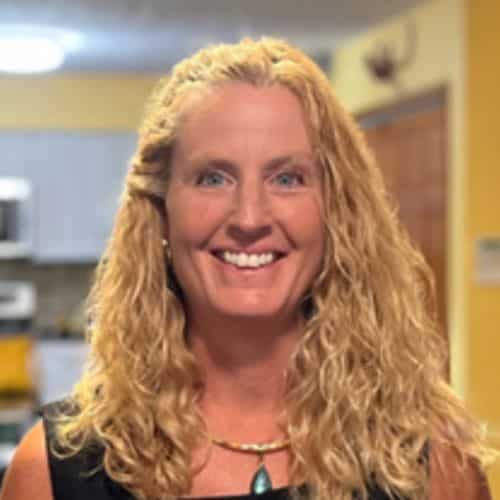
Cherie Garrett
Cherie Garrett is a Spanish teacher at Dallastown Area High School in York County, Pennsylvania, where she incorporates travel into her curriculum because she takes students abroad every other year. While traveling she organizes extra activities to enhance her students’ learning, encouraging students to utilize their Spanish-speaking skills throughout the trip. In the classroom, Cherie frequently does roleplaying of travel situations and shares travel stories and advice with her students.
She is the department chair for the World Language Department at Dallastown Area HS and has been teaching Spanish for the past 30 years, she has the ability to influence her students as well as colleagues. She is the coordinator of the Intermediate World Language Program and the World Language Career Symposium, the advisor of the Global Scholars Program, a proctor of the National Spanish Exam and a frequent presenter at world language conferences. As a member of the Executive Council of PSMLA, Cherie would like to work toward obtaining the Seal of Biliteracy for the state of Pennsylvania, where students are recognized for their proficiency in two or more languages by high school graduation.
Why are you passionate about student travel?
Taking students abroad is extremely fulfilling because I get to share in their discovery of unfamiliar places and cultures. It’s incredibly rewarding to observe them confidently put their second language skills into practice, navigating real-world interactions like bargaining in a bustling marketplace, ordering a meal, or asking for directions from native speakers. Furthermore, I feel a great sense of pride when my students make connections between their classroom learning and the new culture albeit in geography, history, cuisine or traditions.
What is a major highlight from any of your student travel experiences?
A truly unforgettable highlight of our last student trip to Peru was journeying across Lake Titicaca to connect with the indigenous Uros people. We sought to understand their unique way of life on remarkable floating islands, ingeniously constructed from totora reeds – a tradition born centuries ago as a means of escaping the Incan empire’s expansion. Our adventure began with a thirty-minute boat ride across the immense lake, bringing us directly to this indigenous community. Stepping onto the springy reed surface, we were warmly welcomed by the islanders and our interpreter, who skillfully navigated communication in Aymara, Spanish, and English. My students were absolutely enthralled by the Uros’ way of life and the traditions they shared and in just one day, my students gained a much broader perspective on how people around the world live.
What is the greatest lesson you or your students have learned from your trips?
Travel has profoundly expanded my students’ understanding of how everyday life differs across cultures. They’ve come to realize that even seemingly simple habits—like disposing of toilet paper in a wastebasket rather than flushing it—can reflect deeper differences in infrastructure. They’ve also observed the strong emphasis on land conservation, a value often less prioritized in the United States. In addition, experiencing the efficiency and affordability of public transportation in many Spanish-speaking countries highlighted a stark contrast to the limited options available in our home state
How do you try to tie your travel experiences back into the classroom?
I strive to transform my travel experiences into dynamic classroom lessons, fostering authentic cultural connections with the Spanish-speaking world. I weave photos and engaging stories, delivered in the target language, into my curriculum, not only teaching about diverse countries but also inspiring my students to explore the world. My classroom itself becomes a living museum, adorned with ‘treasures’ from my travels. For instance, when distinguishing between llamas and alpacas, I brought in tangible examples – stuffed animals made of alpaca, baby alpaca, and llama wool – allowing students to experience the subtle differences firsthand.
What do you do to prepare your students for the student trip abroad?
To maximize the impact of student travel, I begin building cultural understanding long before departure. Within my own classes, I weave comprehensive units covering the target country’s history, art, cuisine, and geography directly into the curriculum. Recognizing that some travelers aren’t in my courses, I supplement this foundation by hosting engaging monthly meetings for the entire group. These sessions allow us to dive deeper into specific highlights they’ll encounter. For instance, anticipating our visit in June to Madrid’s Prado Museum, our recent meetings focused sharply on Goya and Velázquez. We explored their lives and legacies through introductory videos, then moved into an interactive gallery walk challenging students to match paintings with their titles. Finally, we analyzed key masterpieces together, unpacking their significance so students are able to appreciate these works fully when they see them in person.
From the nominator:
What qualities make this nominee, both as an educator and travel leader, deserving of this award?
Cherie is the type of teacher that goes above and beyond and instills the love of culture and language into her students. It’s no surprise that students continue to take Spanish classes and enroll in upper levels so they can have her as their teacher. In her classroom, she believes in a communicative and cultural approach where students use the language in context on a daily basis as they learn extensively about relevant themes and cultural aspects of the Spanish-speaking world.
Also, she would like to share with world language teachers’ ways to link their curriculum to career pathways so that students are better prepared for making career choices and see the connection between their language of focus and a future career. In addition to her contributions in the classroom and with outside organizations, Cherie incorporates travel into her curriculum. She takes her students abroad every other year giving them the opportunity to use their Spanish skills in life situations and learn the importance of traveling and learning about other cultures.
Photo courtesy of Cherie Garrett.

